Islamic Banking: Digital Marketing Strategies in Bangladesh Context
VerifiedAdded on 2020/06/04
|23
|8796
|417
Literature Review
AI Summary
This literature review explores digital marketing strategies and communication channels used by the Islamic banking industry in Bangladesh. It begins with an overview of the country's background, including its demographics, economy, and banking sectors, differentiating between conventional and Islamic banking. The review then delves into Islamic banking and finance, covering its history, principles, and financial services. It examines the effectiveness of current marketing strategies and communication channels employed by Islamic Financial Institutions in Bangladesh. The study analyzes various research scholars' arguments and insights on the topic, offering a comprehensive understanding of the digital marketing landscape within the Islamic banking sector in Bangladesh. It covers the business scenario of banking sectors in Bangladesh. It also highlights the marketing strategies and communication channels that are used by Islamic banking systems and their effectiveness in influencing borrowing decisions.
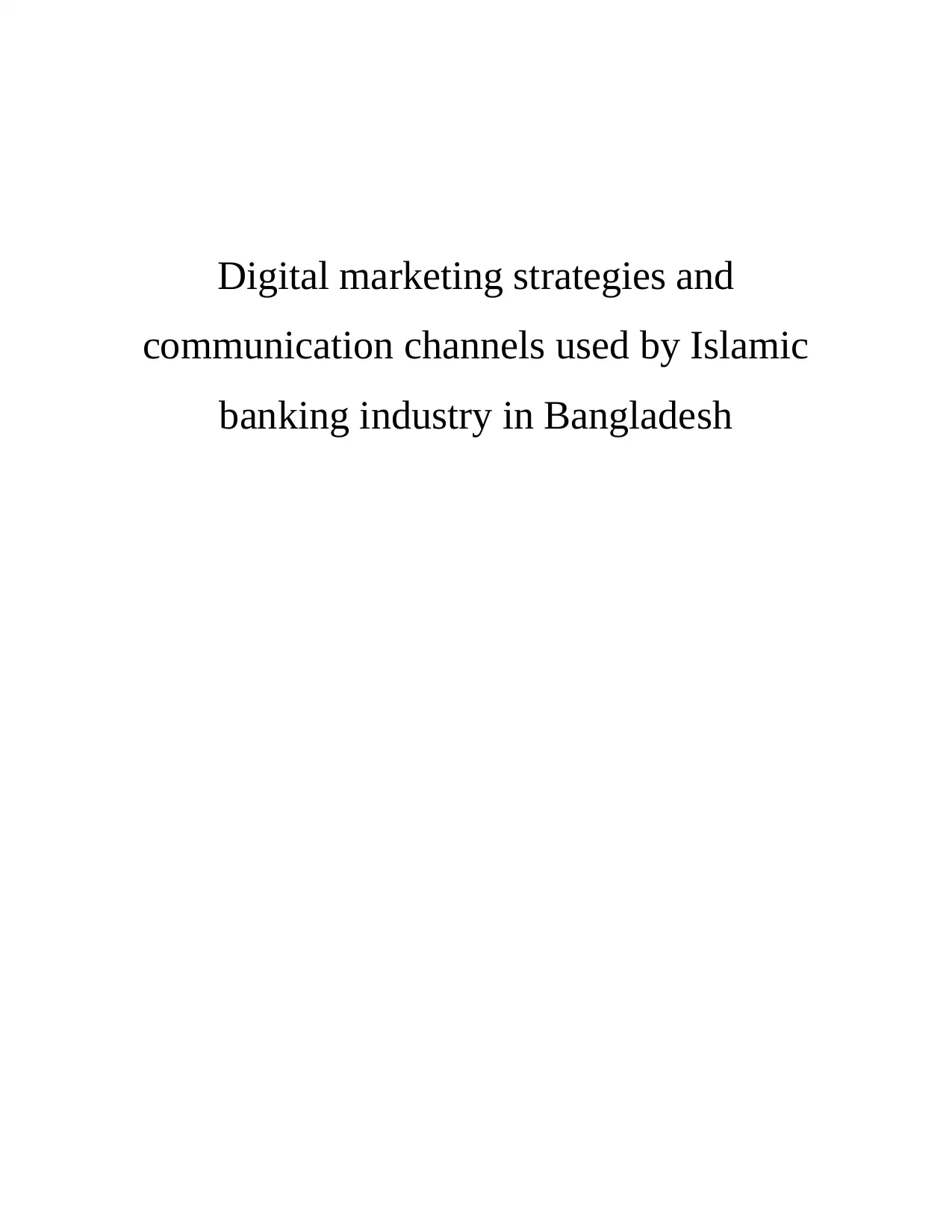
Digital marketing strategies and
communication channels used by Islamic
banking industry in Bangladesh
communication channels used by Islamic
banking industry in Bangladesh
Paraphrase This Document
Need a fresh take? Get an instant paraphrase of this document with our AI Paraphraser
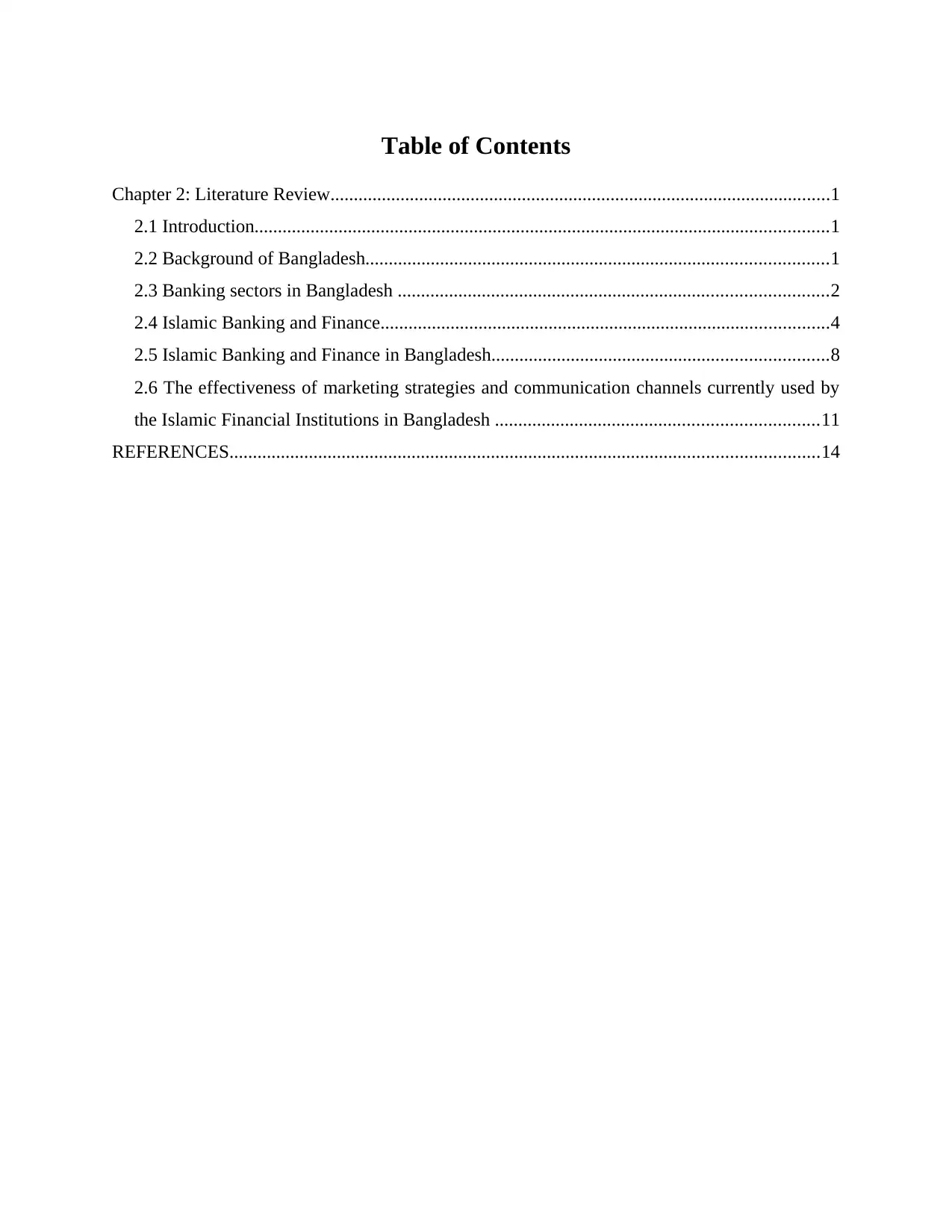
Table of Contents
Chapter 2: Literature Review...........................................................................................................1
2.1 Introduction...........................................................................................................................1
2.2 Background of Bangladesh...................................................................................................1
2.3 Banking sectors in Bangladesh ............................................................................................2
2.4 Islamic Banking and Finance................................................................................................4
2.5 Islamic Banking and Finance in Bangladesh........................................................................8
2.6 The effectiveness of marketing strategies and communication channels currently used by
the Islamic Financial Institutions in Bangladesh .....................................................................11
REFERENCES..............................................................................................................................14
Chapter 2: Literature Review...........................................................................................................1
2.1 Introduction...........................................................................................................................1
2.2 Background of Bangladesh...................................................................................................1
2.3 Banking sectors in Bangladesh ............................................................................................2
2.4 Islamic Banking and Finance................................................................................................4
2.5 Islamic Banking and Finance in Bangladesh........................................................................8
2.6 The effectiveness of marketing strategies and communication channels currently used by
the Islamic Financial Institutions in Bangladesh .....................................................................11
REFERENCES..............................................................................................................................14

Chapter 2: Literature Review
2.1 Introduction
Literature review in dissertation covers the reviews and arguments of various research
scholars, authors and philosophers. In accordance with this context, this chapter will cover the
literature review of digital marketing strategies and communication channels used by Islamic
banking industry in Bangladesh. The demographic, geographic and political study of Bangladesh
will be made in this chapter. Further, types of banking sector incorporated in Bangladesh will be
examined in this dissertation. Islamic Banking and Finance, it history and financial services will
be covered and its impact on Bangladesh banking sector will be investigated. Finally,
effectiveness of marketing strategies and communication channel used by Islamic Financial
Institutions in Bangladesh will be analysed.
2.2 Background of Bangladesh
The country of Bengal, officially the “People's Republic of Bangladesh” is a country of
South Asia. Bangladesh shares its boundaries with countries like India and Myanmar and it is the
eighth most populous country in the world (Khan and et.al., 2017). The national capital of
Bangladesh is Dhaka and the official language for communication is Bengali. The country got its
Independence from Pakistan in the year 1971. According to 2011 census the total population of
Bangladesh was around 142.3 million. Almost 80% of people follow Islam as their religion
(Rahman and Akter, 2017). The country is known for its biodiversity, rivers, sea beaches and
coral reefs. Bangladesh is the middle power and also a developing country (Akhter and Wilson,
2016). The currency of Bangladesh is Taka. The gross domestic product (GDP) of Bangladesh
calculated in 2016 was approximately US$209 billion. Kamal, (2015) said that the economy of
the country rising rapidly and with constant efforts of both government and people Bangladesh’s
economy will surpass the economy of other countries effectively and efficiently. Kamal, Hasan
and Davey, (2015) argued that there are limited number of giant industries and large companies
incorporated in the country, this is reason of lack of growth and development of the economy.
Bangladesh is known for its rich cultural inhabitants and textiles industries. According to
Islam, Rahman and Mostofa, (2017) the policies and legislation formulated by current
government will help in boosting the economy of the country effectively. There is a huge scope
of entrance of new markets that will aid in increasing the economy effectively and efficiently.
Das, 2015 contends that the country is notable for its soil fertility land, including the Ganges
1
2.1 Introduction
Literature review in dissertation covers the reviews and arguments of various research
scholars, authors and philosophers. In accordance with this context, this chapter will cover the
literature review of digital marketing strategies and communication channels used by Islamic
banking industry in Bangladesh. The demographic, geographic and political study of Bangladesh
will be made in this chapter. Further, types of banking sector incorporated in Bangladesh will be
examined in this dissertation. Islamic Banking and Finance, it history and financial services will
be covered and its impact on Bangladesh banking sector will be investigated. Finally,
effectiveness of marketing strategies and communication channel used by Islamic Financial
Institutions in Bangladesh will be analysed.
2.2 Background of Bangladesh
The country of Bengal, officially the “People's Republic of Bangladesh” is a country of
South Asia. Bangladesh shares its boundaries with countries like India and Myanmar and it is the
eighth most populous country in the world (Khan and et.al., 2017). The national capital of
Bangladesh is Dhaka and the official language for communication is Bengali. The country got its
Independence from Pakistan in the year 1971. According to 2011 census the total population of
Bangladesh was around 142.3 million. Almost 80% of people follow Islam as their religion
(Rahman and Akter, 2017). The country is known for its biodiversity, rivers, sea beaches and
coral reefs. Bangladesh is the middle power and also a developing country (Akhter and Wilson,
2016). The currency of Bangladesh is Taka. The gross domestic product (GDP) of Bangladesh
calculated in 2016 was approximately US$209 billion. Kamal, (2015) said that the economy of
the country rising rapidly and with constant efforts of both government and people Bangladesh’s
economy will surpass the economy of other countries effectively and efficiently. Kamal, Hasan
and Davey, (2015) argued that there are limited number of giant industries and large companies
incorporated in the country, this is reason of lack of growth and development of the economy.
Bangladesh is known for its rich cultural inhabitants and textiles industries. According to
Islam, Rahman and Mostofa, (2017) the policies and legislation formulated by current
government will help in boosting the economy of the country effectively. There is a huge scope
of entrance of new markets that will aid in increasing the economy effectively and efficiently.
Das, 2015 contends that the country is notable for its soil fertility land, including the Ganges
1
⊘ This is a preview!⊘
Do you want full access?
Subscribe today to unlock all pages.

Trusted by 1+ million students worldwide
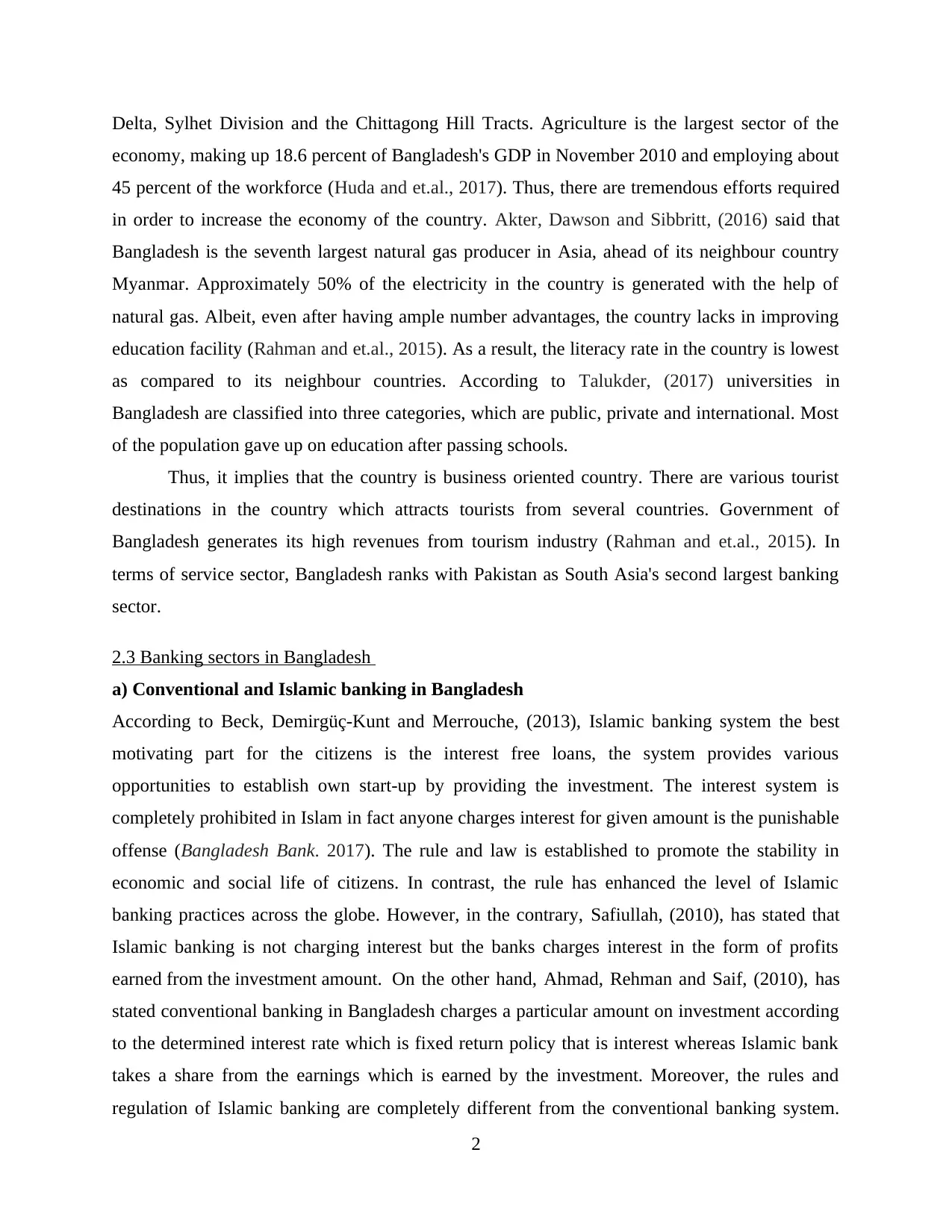
Delta, Sylhet Division and the Chittagong Hill Tracts. Agriculture is the largest sector of the
economy, making up 18.6 percent of Bangladesh's GDP in November 2010 and employing about
45 percent of the workforce (Huda and et.al., 2017). Thus, there are tremendous efforts required
in order to increase the economy of the country. Akter, Dawson and Sibbritt, (2016) said that
Bangladesh is the seventh largest natural gas producer in Asia, ahead of its neighbour country
Myanmar. Approximately 50% of the electricity in the country is generated with the help of
natural gas. Albeit, even after having ample number advantages, the country lacks in improving
education facility (Rahman and et.al., 2015). As a result, the literacy rate in the country is lowest
as compared to its neighbour countries. According to Talukder, (2017) universities in
Bangladesh are classified into three categories, which are public, private and international. Most
of the population gave up on education after passing schools.
Thus, it implies that the country is business oriented country. There are various tourist
destinations in the country which attracts tourists from several countries. Government of
Bangladesh generates its high revenues from tourism industry (Rahman and et.al., 2015). In
terms of service sector, Bangladesh ranks with Pakistan as South Asia's second largest banking
sector.
2.3 Banking sectors in Bangladesh
a) Conventional and Islamic banking in Bangladesh
According to Beck, Demirgüç-Kunt and Merrouche, (2013), Islamic banking system the best
motivating part for the citizens is the interest free loans, the system provides various
opportunities to establish own start-up by providing the investment. The interest system is
completely prohibited in Islam in fact anyone charges interest for given amount is the punishable
offense (Bangladesh Bank. 2017). The rule and law is established to promote the stability in
economic and social life of citizens. In contrast, the rule has enhanced the level of Islamic
banking practices across the globe. However, in the contrary, Safiullah, (2010), has stated that
Islamic banking is not charging interest but the banks charges interest in the form of profits
earned from the investment amount. On the other hand, Ahmad, Rehman and Saif, (2010), has
stated conventional banking in Bangladesh charges a particular amount on investment according
to the determined interest rate which is fixed return policy that is interest whereas Islamic bank
takes a share from the earnings which is earned by the investment. Moreover, the rules and
regulation of Islamic banking are completely different from the conventional banking system.
2
economy, making up 18.6 percent of Bangladesh's GDP in November 2010 and employing about
45 percent of the workforce (Huda and et.al., 2017). Thus, there are tremendous efforts required
in order to increase the economy of the country. Akter, Dawson and Sibbritt, (2016) said that
Bangladesh is the seventh largest natural gas producer in Asia, ahead of its neighbour country
Myanmar. Approximately 50% of the electricity in the country is generated with the help of
natural gas. Albeit, even after having ample number advantages, the country lacks in improving
education facility (Rahman and et.al., 2015). As a result, the literacy rate in the country is lowest
as compared to its neighbour countries. According to Talukder, (2017) universities in
Bangladesh are classified into three categories, which are public, private and international. Most
of the population gave up on education after passing schools.
Thus, it implies that the country is business oriented country. There are various tourist
destinations in the country which attracts tourists from several countries. Government of
Bangladesh generates its high revenues from tourism industry (Rahman and et.al., 2015). In
terms of service sector, Bangladesh ranks with Pakistan as South Asia's second largest banking
sector.
2.3 Banking sectors in Bangladesh
a) Conventional and Islamic banking in Bangladesh
According to Beck, Demirgüç-Kunt and Merrouche, (2013), Islamic banking system the best
motivating part for the citizens is the interest free loans, the system provides various
opportunities to establish own start-up by providing the investment. The interest system is
completely prohibited in Islam in fact anyone charges interest for given amount is the punishable
offense (Bangladesh Bank. 2017). The rule and law is established to promote the stability in
economic and social life of citizens. In contrast, the rule has enhanced the level of Islamic
banking practices across the globe. However, in the contrary, Safiullah, (2010), has stated that
Islamic banking is not charging interest but the banks charges interest in the form of profits
earned from the investment amount. On the other hand, Ahmad, Rehman and Saif, (2010), has
stated conventional banking in Bangladesh charges a particular amount on investment according
to the determined interest rate which is fixed return policy that is interest whereas Islamic bank
takes a share from the earnings which is earned by the investment. Moreover, the rules and
regulation of Islamic banking are completely different from the conventional banking system.
2
Paraphrase This Document
Need a fresh take? Get an instant paraphrase of this document with our AI Paraphraser
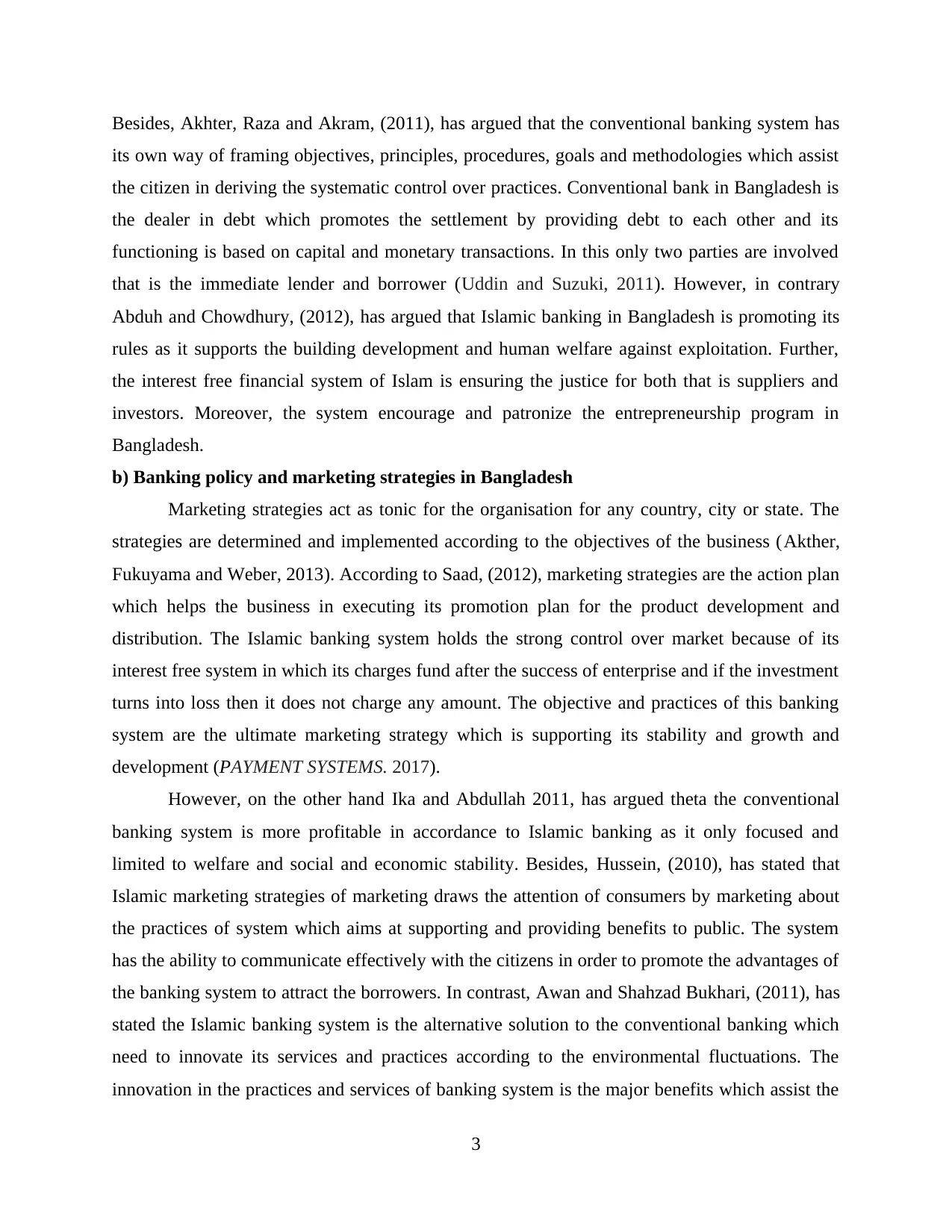
Besides, Akhter, Raza and Akram, (2011), has argued that the conventional banking system has
its own way of framing objectives, principles, procedures, goals and methodologies which assist
the citizen in deriving the systematic control over practices. Conventional bank in Bangladesh is
the dealer in debt which promotes the settlement by providing debt to each other and its
functioning is based on capital and monetary transactions. In this only two parties are involved
that is the immediate lender and borrower (Uddin and Suzuki, 2011). However, in contrary
Abduh and Chowdhury, (2012), has argued that Islamic banking in Bangladesh is promoting its
rules as it supports the building development and human welfare against exploitation. Further,
the interest free financial system of Islam is ensuring the justice for both that is suppliers and
investors. Moreover, the system encourage and patronize the entrepreneurship program in
Bangladesh.
b) Banking policy and marketing strategies in Bangladesh
Marketing strategies act as tonic for the organisation for any country, city or state. The
strategies are determined and implemented according to the objectives of the business (Akther,
Fukuyama and Weber, 2013). According to Saad, (2012), marketing strategies are the action plan
which helps the business in executing its promotion plan for the product development and
distribution. The Islamic banking system holds the strong control over market because of its
interest free system in which its charges fund after the success of enterprise and if the investment
turns into loss then it does not charge any amount. The objective and practices of this banking
system are the ultimate marketing strategy which is supporting its stability and growth and
development (PAYMENT SYSTEMS. 2017).
However, on the other hand Ika and Abdullah 2011, has argued theta the conventional
banking system is more profitable in accordance to Islamic banking as it only focused and
limited to welfare and social and economic stability. Besides, Hussein, (2010), has stated that
Islamic marketing strategies of marketing draws the attention of consumers by marketing about
the practices of system which aims at supporting and providing benefits to public. The system
has the ability to communicate effectively with the citizens in order to promote the advantages of
the banking system to attract the borrowers. In contrast, Awan and Shahzad Bukhari, (2011), has
stated the Islamic banking system is the alternative solution to the conventional banking which
need to innovate its services and practices according to the environmental fluctuations. The
innovation in the practices and services of banking system is the major benefits which assist the
3
its own way of framing objectives, principles, procedures, goals and methodologies which assist
the citizen in deriving the systematic control over practices. Conventional bank in Bangladesh is
the dealer in debt which promotes the settlement by providing debt to each other and its
functioning is based on capital and monetary transactions. In this only two parties are involved
that is the immediate lender and borrower (Uddin and Suzuki, 2011). However, in contrary
Abduh and Chowdhury, (2012), has argued that Islamic banking in Bangladesh is promoting its
rules as it supports the building development and human welfare against exploitation. Further,
the interest free financial system of Islam is ensuring the justice for both that is suppliers and
investors. Moreover, the system encourage and patronize the entrepreneurship program in
Bangladesh.
b) Banking policy and marketing strategies in Bangladesh
Marketing strategies act as tonic for the organisation for any country, city or state. The
strategies are determined and implemented according to the objectives of the business (Akther,
Fukuyama and Weber, 2013). According to Saad, (2012), marketing strategies are the action plan
which helps the business in executing its promotion plan for the product development and
distribution. The Islamic banking system holds the strong control over market because of its
interest free system in which its charges fund after the success of enterprise and if the investment
turns into loss then it does not charge any amount. The objective and practices of this banking
system are the ultimate marketing strategy which is supporting its stability and growth and
development (PAYMENT SYSTEMS. 2017).
However, on the other hand Ika and Abdullah 2011, has argued theta the conventional
banking system is more profitable in accordance to Islamic banking as it only focused and
limited to welfare and social and economic stability. Besides, Hussein, (2010), has stated that
Islamic marketing strategies of marketing draws the attention of consumers by marketing about
the practices of system which aims at supporting and providing benefits to public. The system
has the ability to communicate effectively with the citizens in order to promote the advantages of
the banking system to attract the borrowers. In contrast, Awan and Shahzad Bukhari, (2011), has
stated the Islamic banking system is the alternative solution to the conventional banking which
need to innovate its services and practices according to the environmental fluctuations. The
innovation in the practices and services of banking system is the major benefits which assist the
3
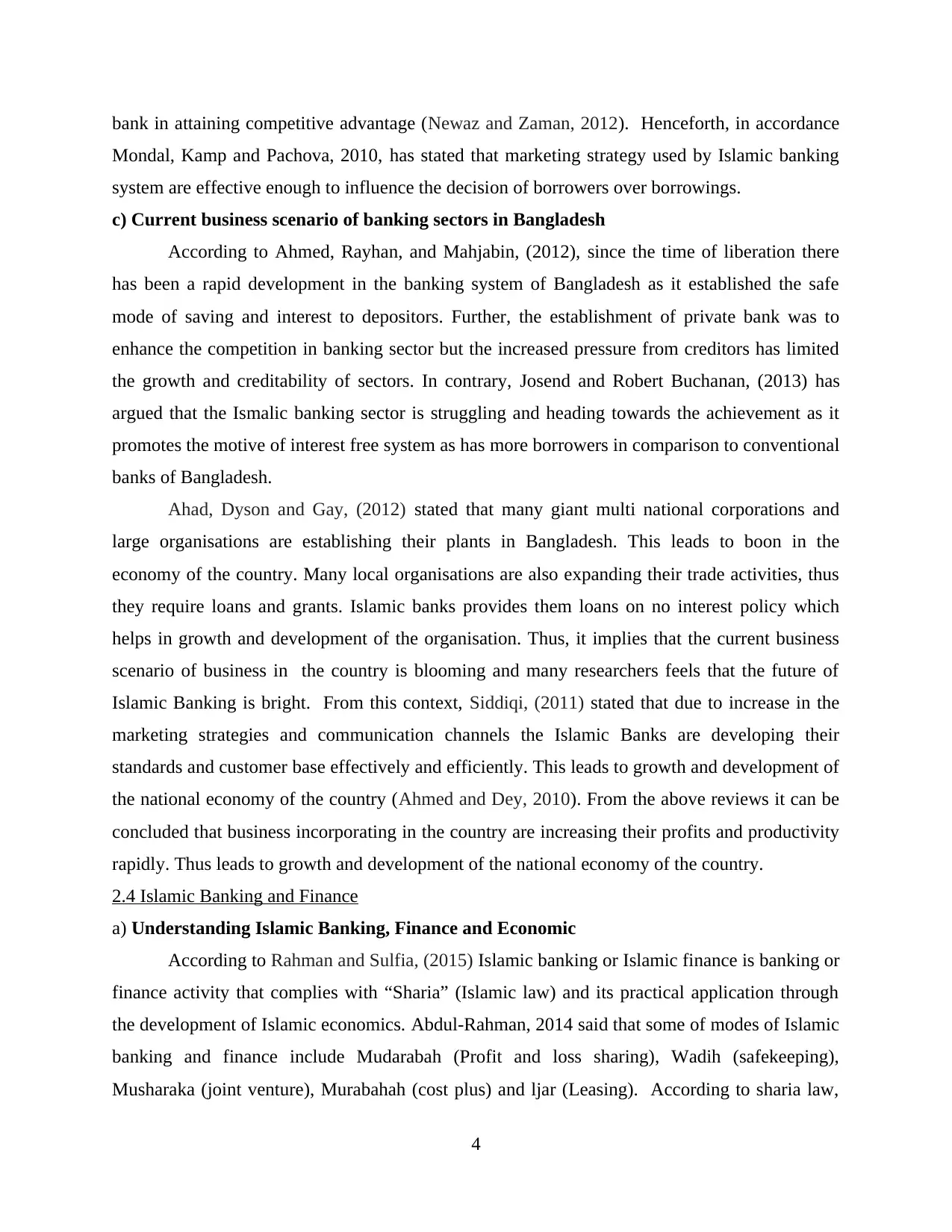
bank in attaining competitive advantage (Newaz and Zaman, 2012). Henceforth, in accordance
Mondal, Kamp and Pachova, 2010, has stated that marketing strategy used by Islamic banking
system are effective enough to influence the decision of borrowers over borrowings.
c) Current business scenario of banking sectors in Bangladesh
According to Ahmed, Rayhan, and Mahjabin, (2012), since the time of liberation there
has been a rapid development in the banking system of Bangladesh as it established the safe
mode of saving and interest to depositors. Further, the establishment of private bank was to
enhance the competition in banking sector but the increased pressure from creditors has limited
the growth and creditability of sectors. In contrary, Josend and Robert Buchanan, (2013) has
argued that the Ismalic banking sector is struggling and heading towards the achievement as it
promotes the motive of interest free system as has more borrowers in comparison to conventional
banks of Bangladesh.
Ahad, Dyson and Gay, (2012) stated that many giant multi national corporations and
large organisations are establishing their plants in Bangladesh. This leads to boon in the
economy of the country. Many local organisations are also expanding their trade activities, thus
they require loans and grants. Islamic banks provides them loans on no interest policy which
helps in growth and development of the organisation. Thus, it implies that the current business
scenario of business in the country is blooming and many researchers feels that the future of
Islamic Banking is bright. From this context, Siddiqi, (2011) stated that due to increase in the
marketing strategies and communication channels the Islamic Banks are developing their
standards and customer base effectively and efficiently. This leads to growth and development of
the national economy of the country (Ahmed and Dey, 2010). From the above reviews it can be
concluded that business incorporating in the country are increasing their profits and productivity
rapidly. Thus leads to growth and development of the national economy of the country.
2.4 Islamic Banking and Finance
a) Understanding Islamic Banking, Finance and Economic
According to Rahman and Sulfia, (2015) Islamic banking or Islamic finance is banking or
finance activity that complies with “Sharia” (Islamic law) and its practical application through
the development of Islamic economics. Abdul-Rahman, 2014 said that some of modes of Islamic
banking and finance include Mudarabah (Profit and loss sharing), Wadih (safekeeping),
Musharaka (joint venture), Murabahah (cost plus) and ljar (Leasing). According to sharia law,
4
Mondal, Kamp and Pachova, 2010, has stated that marketing strategy used by Islamic banking
system are effective enough to influence the decision of borrowers over borrowings.
c) Current business scenario of banking sectors in Bangladesh
According to Ahmed, Rayhan, and Mahjabin, (2012), since the time of liberation there
has been a rapid development in the banking system of Bangladesh as it established the safe
mode of saving and interest to depositors. Further, the establishment of private bank was to
enhance the competition in banking sector but the increased pressure from creditors has limited
the growth and creditability of sectors. In contrary, Josend and Robert Buchanan, (2013) has
argued that the Ismalic banking sector is struggling and heading towards the achievement as it
promotes the motive of interest free system as has more borrowers in comparison to conventional
banks of Bangladesh.
Ahad, Dyson and Gay, (2012) stated that many giant multi national corporations and
large organisations are establishing their plants in Bangladesh. This leads to boon in the
economy of the country. Many local organisations are also expanding their trade activities, thus
they require loans and grants. Islamic banks provides them loans on no interest policy which
helps in growth and development of the organisation. Thus, it implies that the current business
scenario of business in the country is blooming and many researchers feels that the future of
Islamic Banking is bright. From this context, Siddiqi, (2011) stated that due to increase in the
marketing strategies and communication channels the Islamic Banks are developing their
standards and customer base effectively and efficiently. This leads to growth and development of
the national economy of the country (Ahmed and Dey, 2010). From the above reviews it can be
concluded that business incorporating in the country are increasing their profits and productivity
rapidly. Thus leads to growth and development of the national economy of the country.
2.4 Islamic Banking and Finance
a) Understanding Islamic Banking, Finance and Economic
According to Rahman and Sulfia, (2015) Islamic banking or Islamic finance is banking or
finance activity that complies with “Sharia” (Islamic law) and its practical application through
the development of Islamic economics. Abdul-Rahman, 2014 said that some of modes of Islamic
banking and finance include Mudarabah (Profit and loss sharing), Wadih (safekeeping),
Musharaka (joint venture), Murabahah (cost plus) and ljar (Leasing). According to sharia law,
4
⊘ This is a preview!⊘
Do you want full access?
Subscribe today to unlock all pages.

Trusted by 1+ million students worldwide
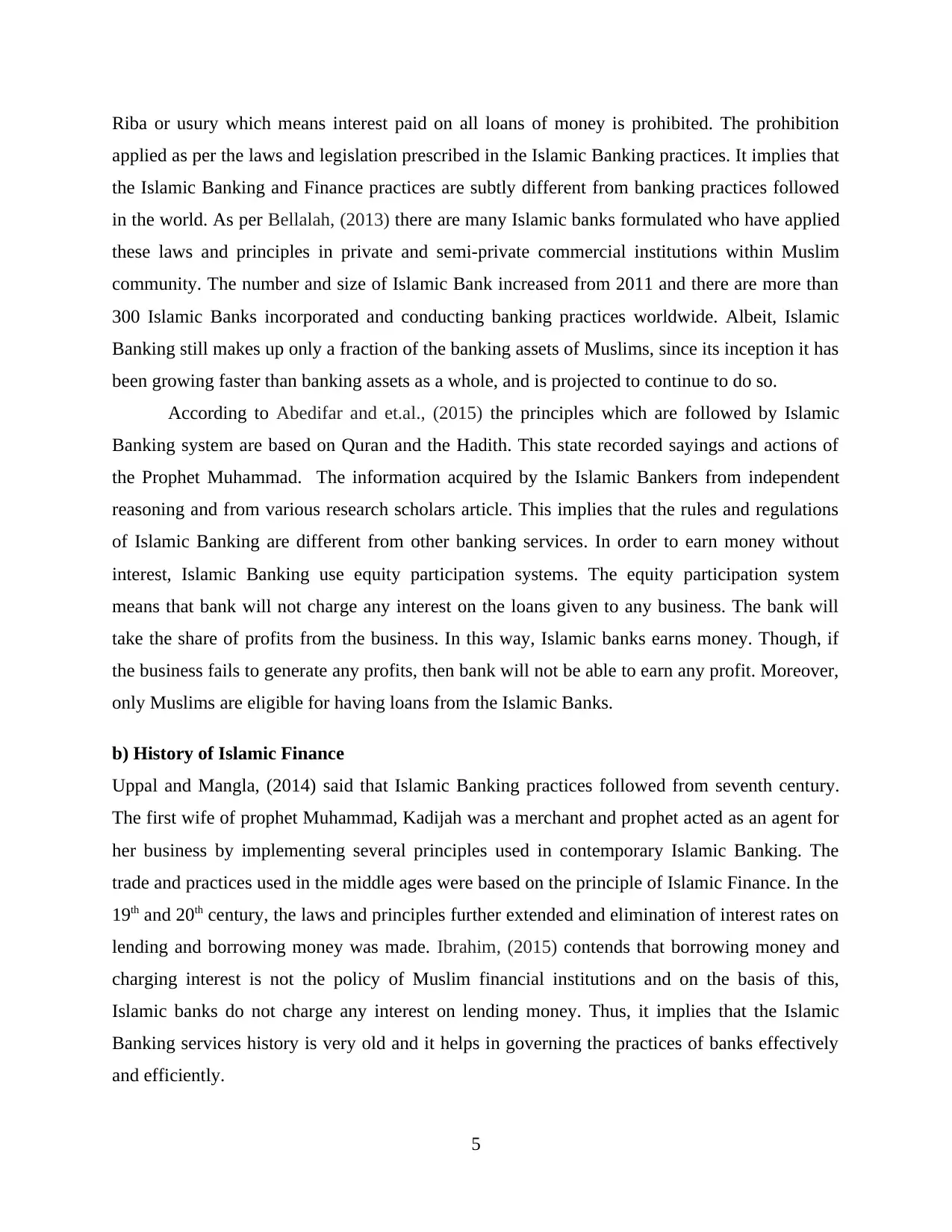
Riba or usury which means interest paid on all loans of money is prohibited. The prohibition
applied as per the laws and legislation prescribed in the Islamic Banking practices. It implies that
the Islamic Banking and Finance practices are subtly different from banking practices followed
in the world. As per Bellalah, (2013) there are many Islamic banks formulated who have applied
these laws and principles in private and semi-private commercial institutions within Muslim
community. The number and size of Islamic Bank increased from 2011 and there are more than
300 Islamic Banks incorporated and conducting banking practices worldwide. Albeit, Islamic
Banking still makes up only a fraction of the banking assets of Muslims, since its inception it has
been growing faster than banking assets as a whole, and is projected to continue to do so.
According to Abedifar and et.al., (2015) the principles which are followed by Islamic
Banking system are based on Quran and the Hadith. This state recorded sayings and actions of
the Prophet Muhammad. The information acquired by the Islamic Bankers from independent
reasoning and from various research scholars article. This implies that the rules and regulations
of Islamic Banking are different from other banking services. In order to earn money without
interest, Islamic Banking use equity participation systems. The equity participation system
means that bank will not charge any interest on the loans given to any business. The bank will
take the share of profits from the business. In this way, Islamic banks earns money. Though, if
the business fails to generate any profits, then bank will not be able to earn any profit. Moreover,
only Muslims are eligible for having loans from the Islamic Banks.
b) History of Islamic Finance
Uppal and Mangla, (2014) said that Islamic Banking practices followed from seventh century.
The first wife of prophet Muhammad, Kadijah was a merchant and prophet acted as an agent for
her business by implementing several principles used in contemporary Islamic Banking. The
trade and practices used in the middle ages were based on the principle of Islamic Finance. In the
19th and 20th century, the laws and principles further extended and elimination of interest rates on
lending and borrowing money was made. Ibrahim, (2015) contends that borrowing money and
charging interest is not the policy of Muslim financial institutions and on the basis of this,
Islamic banks do not charge any interest on lending money. Thus, it implies that the Islamic
Banking services history is very old and it helps in governing the practices of banks effectively
and efficiently.
5
applied as per the laws and legislation prescribed in the Islamic Banking practices. It implies that
the Islamic Banking and Finance practices are subtly different from banking practices followed
in the world. As per Bellalah, (2013) there are many Islamic banks formulated who have applied
these laws and principles in private and semi-private commercial institutions within Muslim
community. The number and size of Islamic Bank increased from 2011 and there are more than
300 Islamic Banks incorporated and conducting banking practices worldwide. Albeit, Islamic
Banking still makes up only a fraction of the banking assets of Muslims, since its inception it has
been growing faster than banking assets as a whole, and is projected to continue to do so.
According to Abedifar and et.al., (2015) the principles which are followed by Islamic
Banking system are based on Quran and the Hadith. This state recorded sayings and actions of
the Prophet Muhammad. The information acquired by the Islamic Bankers from independent
reasoning and from various research scholars article. This implies that the rules and regulations
of Islamic Banking are different from other banking services. In order to earn money without
interest, Islamic Banking use equity participation systems. The equity participation system
means that bank will not charge any interest on the loans given to any business. The bank will
take the share of profits from the business. In this way, Islamic banks earns money. Though, if
the business fails to generate any profits, then bank will not be able to earn any profit. Moreover,
only Muslims are eligible for having loans from the Islamic Banks.
b) History of Islamic Finance
Uppal and Mangla, (2014) said that Islamic Banking practices followed from seventh century.
The first wife of prophet Muhammad, Kadijah was a merchant and prophet acted as an agent for
her business by implementing several principles used in contemporary Islamic Banking. The
trade and practices used in the middle ages were based on the principle of Islamic Finance. In the
19th and 20th century, the laws and principles further extended and elimination of interest rates on
lending and borrowing money was made. Ibrahim, (2015) contends that borrowing money and
charging interest is not the policy of Muslim financial institutions and on the basis of this,
Islamic banks do not charge any interest on lending money. Thus, it implies that the Islamic
Banking services history is very old and it helps in governing the practices of banks effectively
and efficiently.
5
Paraphrase This Document
Need a fresh take? Get an instant paraphrase of this document with our AI Paraphraser
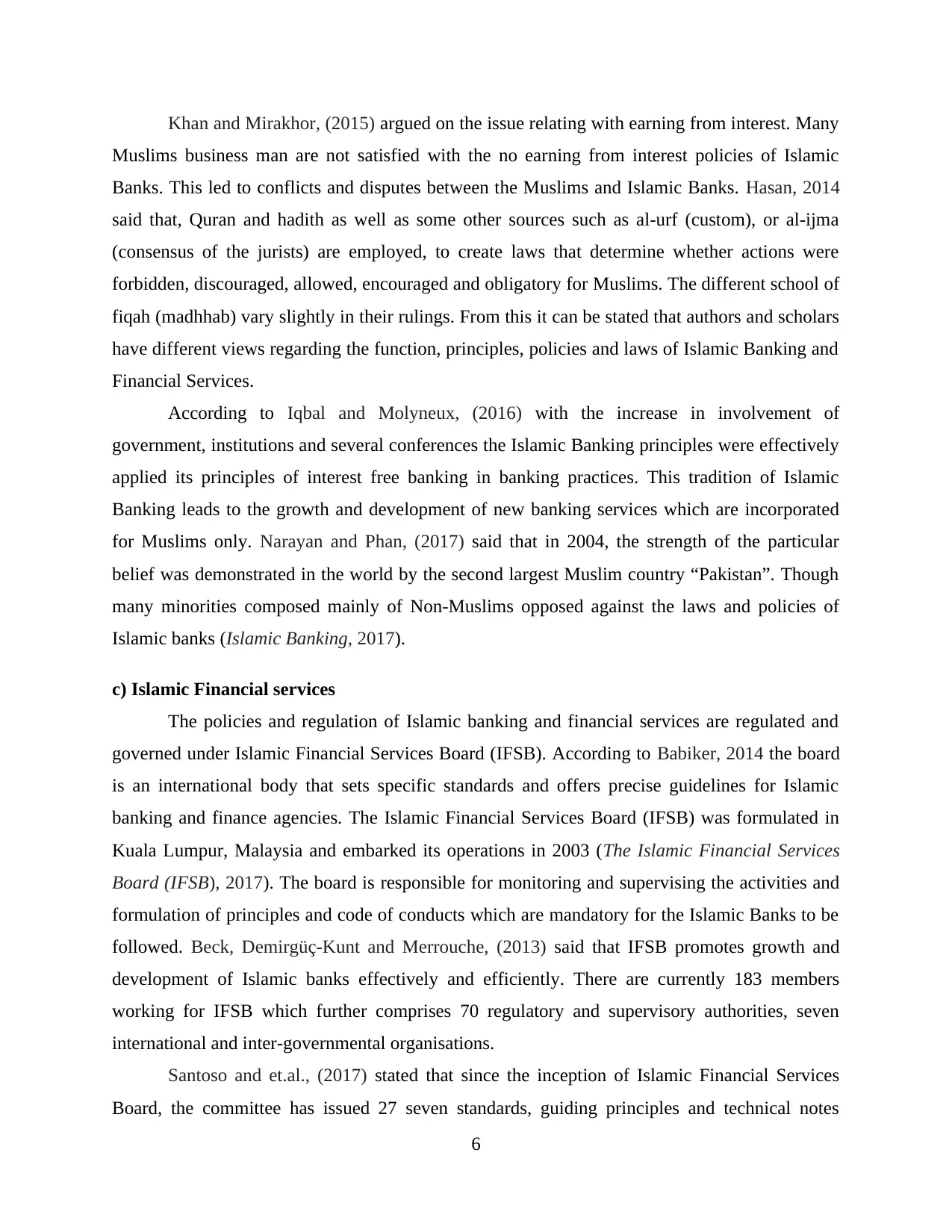
Khan and Mirakhor, (2015) argued on the issue relating with earning from interest. Many
Muslims business man are not satisfied with the no earning from interest policies of Islamic
Banks. This led to conflicts and disputes between the Muslims and Islamic Banks. Hasan, 2014
said that, Quran and hadith as well as some other sources such as al-urf (custom), or al-ijma
(consensus of the jurists) are employed, to create laws that determine whether actions were
forbidden, discouraged, allowed, encouraged and obligatory for Muslims. The different school of
fiqah (madhhab) vary slightly in their rulings. From this it can be stated that authors and scholars
have different views regarding the function, principles, policies and laws of Islamic Banking and
Financial Services.
According to Iqbal and Molyneux, (2016) with the increase in involvement of
government, institutions and several conferences the Islamic Banking principles were effectively
applied its principles of interest free banking in banking practices. This tradition of Islamic
Banking leads to the growth and development of new banking services which are incorporated
for Muslims only. Narayan and Phan, (2017) said that in 2004, the strength of the particular
belief was demonstrated in the world by the second largest Muslim country “Pakistan”. Though
many minorities composed mainly of Non-Muslims opposed against the laws and policies of
Islamic banks (Islamic Banking, 2017).
c) Islamic Financial services
The policies and regulation of Islamic banking and financial services are regulated and
governed under Islamic Financial Services Board (IFSB). According to Babiker, 2014 the board
is an international body that sets specific standards and offers precise guidelines for Islamic
banking and finance agencies. The Islamic Financial Services Board (IFSB) was formulated in
Kuala Lumpur, Malaysia and embarked its operations in 2003 (The Islamic Financial Services
Board (IFSB), 2017). The board is responsible for monitoring and supervising the activities and
formulation of principles and code of conducts which are mandatory for the Islamic Banks to be
followed. Beck, Demirgüç-Kunt and Merrouche, (2013) said that IFSB promotes growth and
development of Islamic banks effectively and efficiently. There are currently 183 members
working for IFSB which further comprises 70 regulatory and supervisory authorities, seven
international and inter-governmental organisations.
Santoso and et.al., (2017) stated that since the inception of Islamic Financial Services
Board, the committee has issued 27 seven standards, guiding principles and technical notes
6
Muslims business man are not satisfied with the no earning from interest policies of Islamic
Banks. This led to conflicts and disputes between the Muslims and Islamic Banks. Hasan, 2014
said that, Quran and hadith as well as some other sources such as al-urf (custom), or al-ijma
(consensus of the jurists) are employed, to create laws that determine whether actions were
forbidden, discouraged, allowed, encouraged and obligatory for Muslims. The different school of
fiqah (madhhab) vary slightly in their rulings. From this it can be stated that authors and scholars
have different views regarding the function, principles, policies and laws of Islamic Banking and
Financial Services.
According to Iqbal and Molyneux, (2016) with the increase in involvement of
government, institutions and several conferences the Islamic Banking principles were effectively
applied its principles of interest free banking in banking practices. This tradition of Islamic
Banking leads to the growth and development of new banking services which are incorporated
for Muslims only. Narayan and Phan, (2017) said that in 2004, the strength of the particular
belief was demonstrated in the world by the second largest Muslim country “Pakistan”. Though
many minorities composed mainly of Non-Muslims opposed against the laws and policies of
Islamic banks (Islamic Banking, 2017).
c) Islamic Financial services
The policies and regulation of Islamic banking and financial services are regulated and
governed under Islamic Financial Services Board (IFSB). According to Babiker, 2014 the board
is an international body that sets specific standards and offers precise guidelines for Islamic
banking and finance agencies. The Islamic Financial Services Board (IFSB) was formulated in
Kuala Lumpur, Malaysia and embarked its operations in 2003 (The Islamic Financial Services
Board (IFSB), 2017). The board is responsible for monitoring and supervising the activities and
formulation of principles and code of conducts which are mandatory for the Islamic Banks to be
followed. Beck, Demirgüç-Kunt and Merrouche, (2013) said that IFSB promotes growth and
development of Islamic banks effectively and efficiently. There are currently 183 members
working for IFSB which further comprises 70 regulatory and supervisory authorities, seven
international and inter-governmental organisations.
Santoso and et.al., (2017) stated that since the inception of Islamic Financial Services
Board, the committee has issued 27 seven standards, guiding principles and technical notes
6
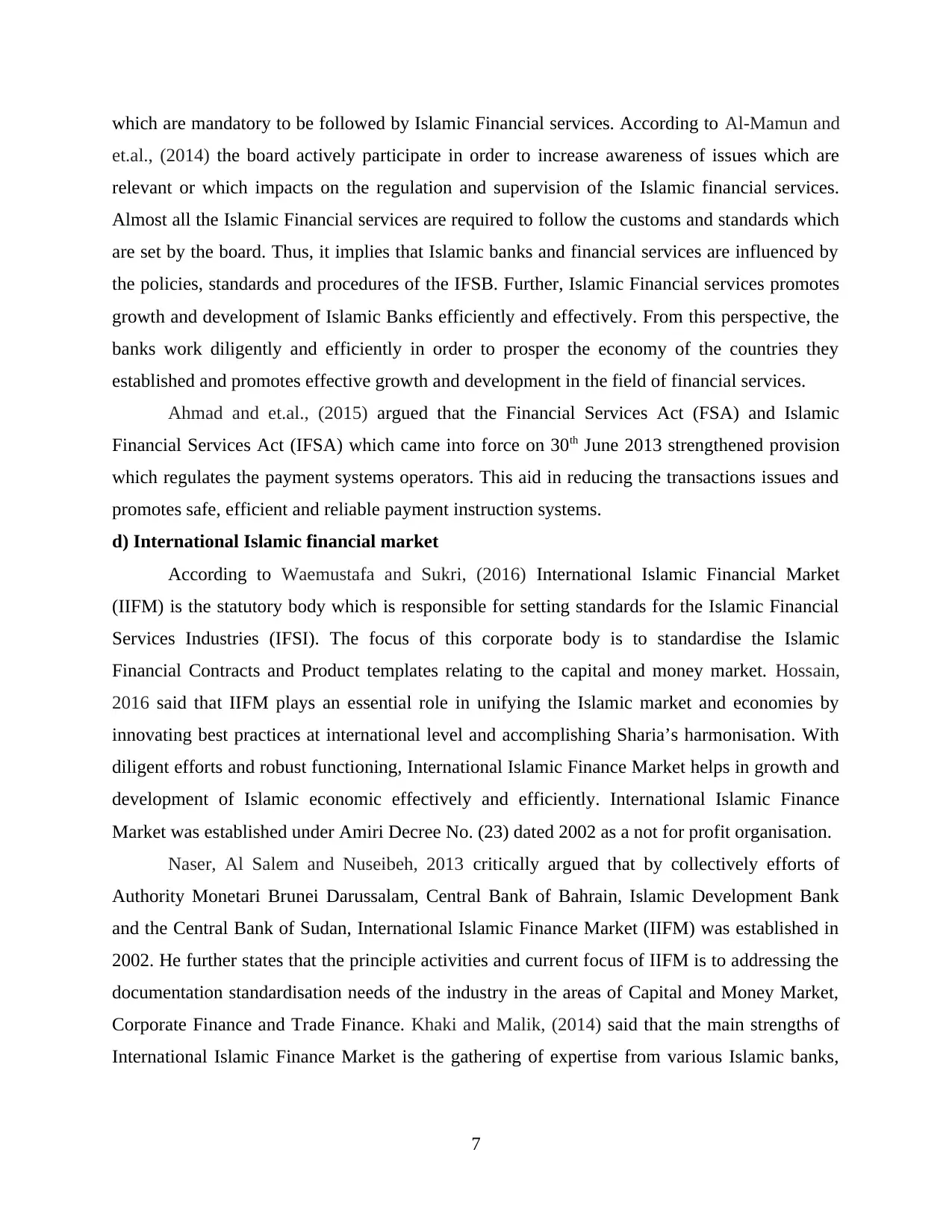
which are mandatory to be followed by Islamic Financial services. According to Al-Mamun and
et.al., (2014) the board actively participate in order to increase awareness of issues which are
relevant or which impacts on the regulation and supervision of the Islamic financial services.
Almost all the Islamic Financial services are required to follow the customs and standards which
are set by the board. Thus, it implies that Islamic banks and financial services are influenced by
the policies, standards and procedures of the IFSB. Further, Islamic Financial services promotes
growth and development of Islamic Banks efficiently and effectively. From this perspective, the
banks work diligently and efficiently in order to prosper the economy of the countries they
established and promotes effective growth and development in the field of financial services.
Ahmad and et.al., (2015) argued that the Financial Services Act (FSA) and Islamic
Financial Services Act (IFSA) which came into force on 30th June 2013 strengthened provision
which regulates the payment systems operators. This aid in reducing the transactions issues and
promotes safe, efficient and reliable payment instruction systems.
d) International Islamic financial market
According to Waemustafa and Sukri, (2016) International Islamic Financial Market
(IIFM) is the statutory body which is responsible for setting standards for the Islamic Financial
Services Industries (IFSI). The focus of this corporate body is to standardise the Islamic
Financial Contracts and Product templates relating to the capital and money market. Hossain,
2016 said that IIFM plays an essential role in unifying the Islamic market and economies by
innovating best practices at international level and accomplishing Sharia’s harmonisation. With
diligent efforts and robust functioning, International Islamic Finance Market helps in growth and
development of Islamic economic effectively and efficiently. International Islamic Finance
Market was established under Amiri Decree No. (23) dated 2002 as a not for profit organisation.
Naser, Al Salem and Nuseibeh, 2013 critically argued that by collectively efforts of
Authority Monetari Brunei Darussalam, Central Bank of Bahrain, Islamic Development Bank
and the Central Bank of Sudan, International Islamic Finance Market (IIFM) was established in
2002. He further states that the principle activities and current focus of IIFM is to addressing the
documentation standardisation needs of the industry in the areas of Capital and Money Market,
Corporate Finance and Trade Finance. Khaki and Malik, (2014) said that the main strengths of
International Islamic Finance Market is the gathering of expertise from various Islamic banks,
7
et.al., (2014) the board actively participate in order to increase awareness of issues which are
relevant or which impacts on the regulation and supervision of the Islamic financial services.
Almost all the Islamic Financial services are required to follow the customs and standards which
are set by the board. Thus, it implies that Islamic banks and financial services are influenced by
the policies, standards and procedures of the IFSB. Further, Islamic Financial services promotes
growth and development of Islamic Banks efficiently and effectively. From this perspective, the
banks work diligently and efficiently in order to prosper the economy of the countries they
established and promotes effective growth and development in the field of financial services.
Ahmad and et.al., (2015) argued that the Financial Services Act (FSA) and Islamic
Financial Services Act (IFSA) which came into force on 30th June 2013 strengthened provision
which regulates the payment systems operators. This aid in reducing the transactions issues and
promotes safe, efficient and reliable payment instruction systems.
d) International Islamic financial market
According to Waemustafa and Sukri, (2016) International Islamic Financial Market
(IIFM) is the statutory body which is responsible for setting standards for the Islamic Financial
Services Industries (IFSI). The focus of this corporate body is to standardise the Islamic
Financial Contracts and Product templates relating to the capital and money market. Hossain,
2016 said that IIFM plays an essential role in unifying the Islamic market and economies by
innovating best practices at international level and accomplishing Sharia’s harmonisation. With
diligent efforts and robust functioning, International Islamic Finance Market helps in growth and
development of Islamic economic effectively and efficiently. International Islamic Finance
Market was established under Amiri Decree No. (23) dated 2002 as a not for profit organisation.
Naser, Al Salem and Nuseibeh, 2013 critically argued that by collectively efforts of
Authority Monetari Brunei Darussalam, Central Bank of Bahrain, Islamic Development Bank
and the Central Bank of Sudan, International Islamic Finance Market (IIFM) was established in
2002. He further states that the principle activities and current focus of IIFM is to addressing the
documentation standardisation needs of the industry in the areas of Capital and Money Market,
Corporate Finance and Trade Finance. Khaki and Malik, (2014) said that the main strengths of
International Islamic Finance Market is the gathering of expertise from various Islamic banks,
7
⊘ This is a preview!⊘
Do you want full access?
Subscribe today to unlock all pages.

Trusted by 1+ million students worldwide
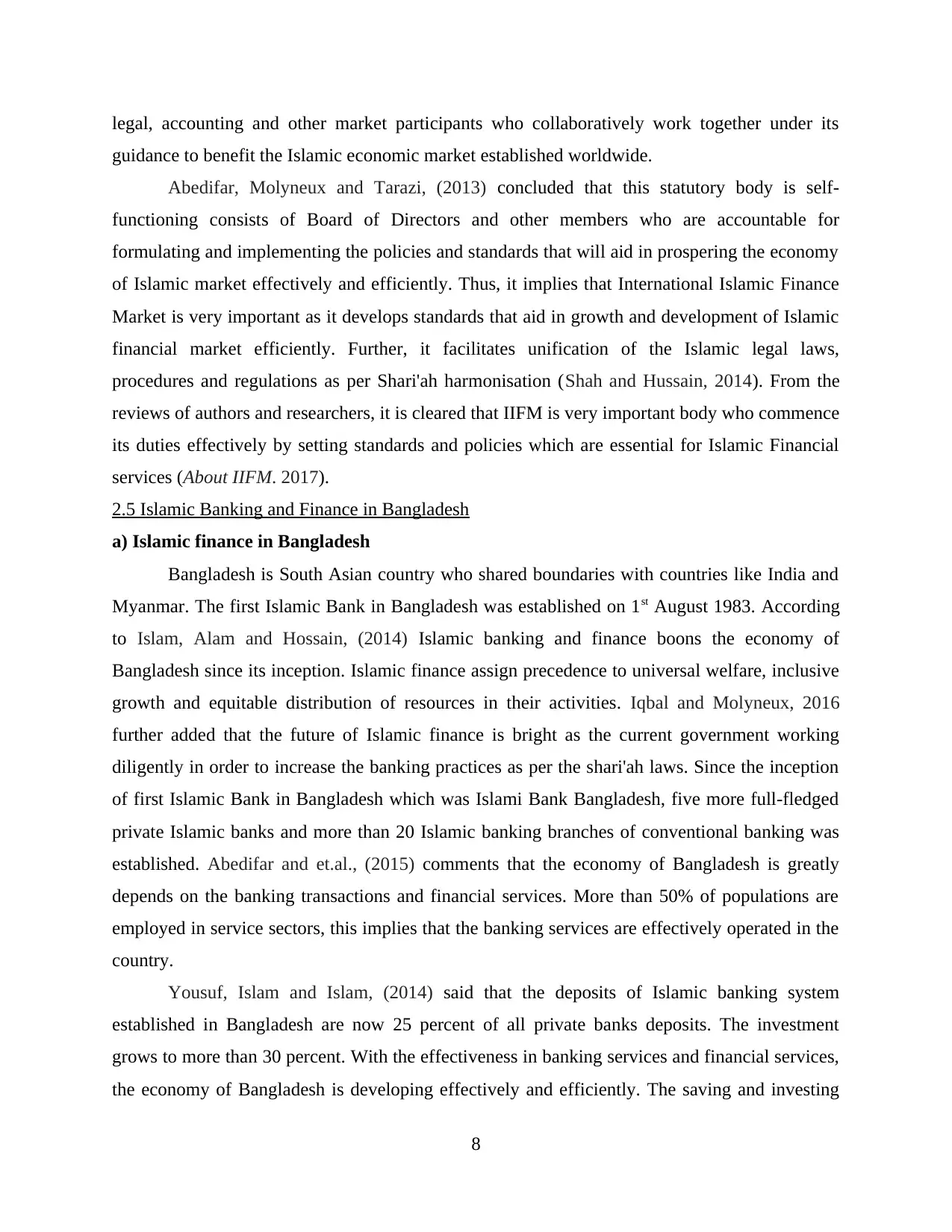
legal, accounting and other market participants who collaboratively work together under its
guidance to benefit the Islamic economic market established worldwide.
Abedifar, Molyneux and Tarazi, (2013) concluded that this statutory body is self-
functioning consists of Board of Directors and other members who are accountable for
formulating and implementing the policies and standards that will aid in prospering the economy
of Islamic market effectively and efficiently. Thus, it implies that International Islamic Finance
Market is very important as it develops standards that aid in growth and development of Islamic
financial market efficiently. Further, it facilitates unification of the Islamic legal laws,
procedures and regulations as per Shari'ah harmonisation (Shah and Hussain, 2014). From the
reviews of authors and researchers, it is cleared that IIFM is very important body who commence
its duties effectively by setting standards and policies which are essential for Islamic Financial
services (About IIFM. 2017).
2.5 Islamic Banking and Finance in Bangladesh
a) Islamic finance in Bangladesh
Bangladesh is South Asian country who shared boundaries with countries like India and
Myanmar. The first Islamic Bank in Bangladesh was established on 1st August 1983. According
to Islam, Alam and Hossain, (2014) Islamic banking and finance boons the economy of
Bangladesh since its inception. Islamic finance assign precedence to universal welfare, inclusive
growth and equitable distribution of resources in their activities. Iqbal and Molyneux, 2016
further added that the future of Islamic finance is bright as the current government working
diligently in order to increase the banking practices as per the shari'ah laws. Since the inception
of first Islamic Bank in Bangladesh which was Islami Bank Bangladesh, five more full-fledged
private Islamic banks and more than 20 Islamic banking branches of conventional banking was
established. Abedifar and et.al., (2015) comments that the economy of Bangladesh is greatly
depends on the banking transactions and financial services. More than 50% of populations are
employed in service sectors, this implies that the banking services are effectively operated in the
country.
Yousuf, Islam and Islam, (2014) said that the deposits of Islamic banking system
established in Bangladesh are now 25 percent of all private banks deposits. The investment
grows to more than 30 percent. With the effectiveness in banking services and financial services,
the economy of Bangladesh is developing effectively and efficiently. The saving and investing
8
guidance to benefit the Islamic economic market established worldwide.
Abedifar, Molyneux and Tarazi, (2013) concluded that this statutory body is self-
functioning consists of Board of Directors and other members who are accountable for
formulating and implementing the policies and standards that will aid in prospering the economy
of Islamic market effectively and efficiently. Thus, it implies that International Islamic Finance
Market is very important as it develops standards that aid in growth and development of Islamic
financial market efficiently. Further, it facilitates unification of the Islamic legal laws,
procedures and regulations as per Shari'ah harmonisation (Shah and Hussain, 2014). From the
reviews of authors and researchers, it is cleared that IIFM is very important body who commence
its duties effectively by setting standards and policies which are essential for Islamic Financial
services (About IIFM. 2017).
2.5 Islamic Banking and Finance in Bangladesh
a) Islamic finance in Bangladesh
Bangladesh is South Asian country who shared boundaries with countries like India and
Myanmar. The first Islamic Bank in Bangladesh was established on 1st August 1983. According
to Islam, Alam and Hossain, (2014) Islamic banking and finance boons the economy of
Bangladesh since its inception. Islamic finance assign precedence to universal welfare, inclusive
growth and equitable distribution of resources in their activities. Iqbal and Molyneux, 2016
further added that the future of Islamic finance is bright as the current government working
diligently in order to increase the banking practices as per the shari'ah laws. Since the inception
of first Islamic Bank in Bangladesh which was Islami Bank Bangladesh, five more full-fledged
private Islamic banks and more than 20 Islamic banking branches of conventional banking was
established. Abedifar and et.al., (2015) comments that the economy of Bangladesh is greatly
depends on the banking transactions and financial services. More than 50% of populations are
employed in service sectors, this implies that the banking services are effectively operated in the
country.
Yousuf, Islam and Islam, (2014) said that the deposits of Islamic banking system
established in Bangladesh are now 25 percent of all private banks deposits. The investment
grows to more than 30 percent. With the effectiveness in banking services and financial services,
the economy of Bangladesh is developing effectively and efficiently. The saving and investing
8
Paraphrase This Document
Need a fresh take? Get an instant paraphrase of this document with our AI Paraphraser
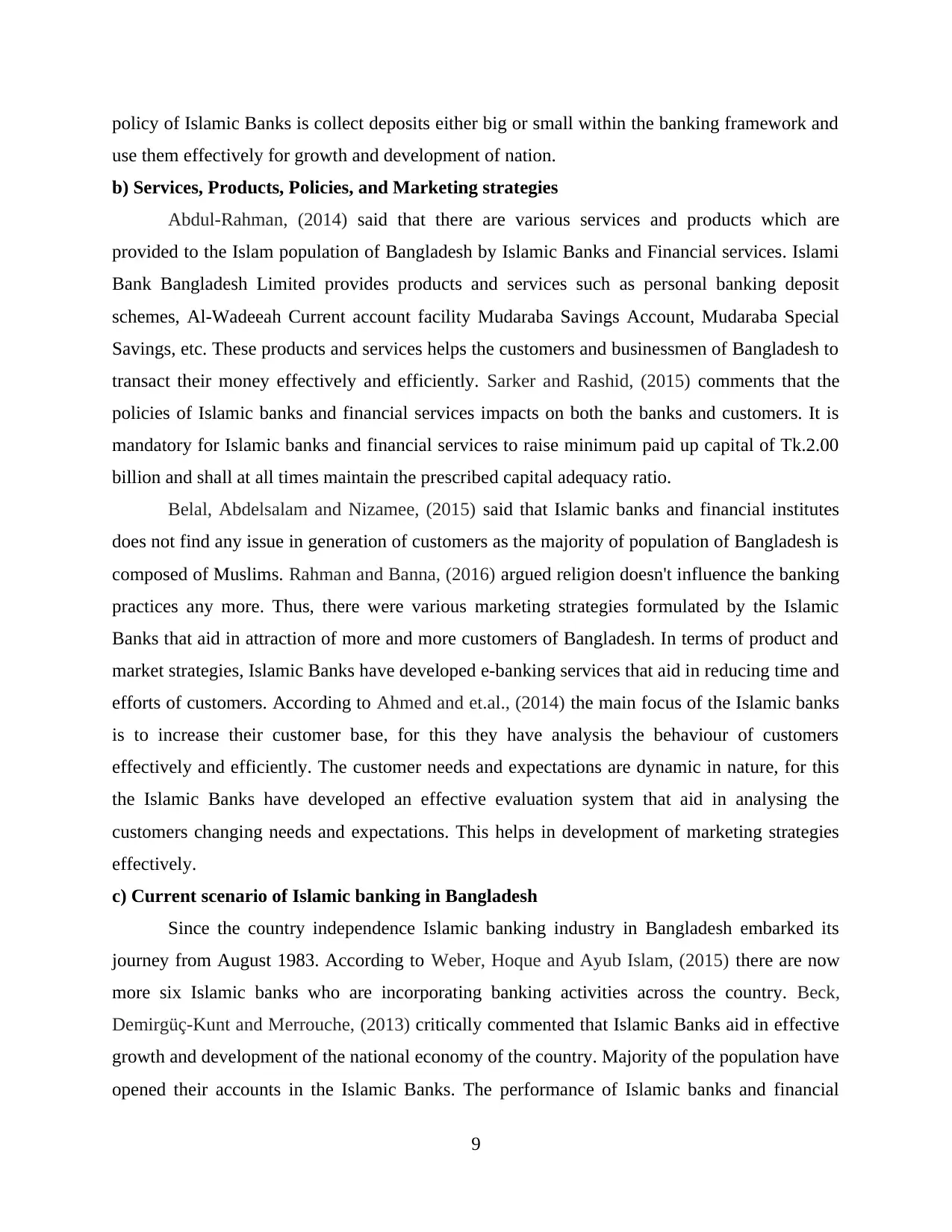
policy of Islamic Banks is collect deposits either big or small within the banking framework and
use them effectively for growth and development of nation.
b) Services, Products, Policies, and Marketing strategies
Abdul-Rahman, (2014) said that there are various services and products which are
provided to the Islam population of Bangladesh by Islamic Banks and Financial services. Islami
Bank Bangladesh Limited provides products and services such as personal banking deposit
schemes, Al-Wadeeah Current account facility Mudaraba Savings Account, Mudaraba Special
Savings, etc. These products and services helps the customers and businessmen of Bangladesh to
transact their money effectively and efficiently. Sarker and Rashid, (2015) comments that the
policies of Islamic banks and financial services impacts on both the banks and customers. It is
mandatory for Islamic banks and financial services to raise minimum paid up capital of Tk.2.00
billion and shall at all times maintain the prescribed capital adequacy ratio.
Belal, Abdelsalam and Nizamee, (2015) said that Islamic banks and financial institutes
does not find any issue in generation of customers as the majority of population of Bangladesh is
composed of Muslims. Rahman and Banna, (2016) argued religion doesn't influence the banking
practices any more. Thus, there were various marketing strategies formulated by the Islamic
Banks that aid in attraction of more and more customers of Bangladesh. In terms of product and
market strategies, Islamic Banks have developed e-banking services that aid in reducing time and
efforts of customers. According to Ahmed and et.al., (2014) the main focus of the Islamic banks
is to increase their customer base, for this they have analysis the behaviour of customers
effectively and efficiently. The customer needs and expectations are dynamic in nature, for this
the Islamic Banks have developed an effective evaluation system that aid in analysing the
customers changing needs and expectations. This helps in development of marketing strategies
effectively.
c) Current scenario of Islamic banking in Bangladesh
Since the country independence Islamic banking industry in Bangladesh embarked its
journey from August 1983. According to Weber, Hoque and Ayub Islam, (2015) there are now
more six Islamic banks who are incorporating banking activities across the country. Beck,
Demirgüç-Kunt and Merrouche, (2013) critically commented that Islamic Banks aid in effective
growth and development of the national economy of the country. Majority of the population have
opened their accounts in the Islamic Banks. The performance of Islamic banks and financial
9
use them effectively for growth and development of nation.
b) Services, Products, Policies, and Marketing strategies
Abdul-Rahman, (2014) said that there are various services and products which are
provided to the Islam population of Bangladesh by Islamic Banks and Financial services. Islami
Bank Bangladesh Limited provides products and services such as personal banking deposit
schemes, Al-Wadeeah Current account facility Mudaraba Savings Account, Mudaraba Special
Savings, etc. These products and services helps the customers and businessmen of Bangladesh to
transact their money effectively and efficiently. Sarker and Rashid, (2015) comments that the
policies of Islamic banks and financial services impacts on both the banks and customers. It is
mandatory for Islamic banks and financial services to raise minimum paid up capital of Tk.2.00
billion and shall at all times maintain the prescribed capital adequacy ratio.
Belal, Abdelsalam and Nizamee, (2015) said that Islamic banks and financial institutes
does not find any issue in generation of customers as the majority of population of Bangladesh is
composed of Muslims. Rahman and Banna, (2016) argued religion doesn't influence the banking
practices any more. Thus, there were various marketing strategies formulated by the Islamic
Banks that aid in attraction of more and more customers of Bangladesh. In terms of product and
market strategies, Islamic Banks have developed e-banking services that aid in reducing time and
efforts of customers. According to Ahmed and et.al., (2014) the main focus of the Islamic banks
is to increase their customer base, for this they have analysis the behaviour of customers
effectively and efficiently. The customer needs and expectations are dynamic in nature, for this
the Islamic Banks have developed an effective evaluation system that aid in analysing the
customers changing needs and expectations. This helps in development of marketing strategies
effectively.
c) Current scenario of Islamic banking in Bangladesh
Since the country independence Islamic banking industry in Bangladesh embarked its
journey from August 1983. According to Weber, Hoque and Ayub Islam, (2015) there are now
more six Islamic banks who are incorporating banking activities across the country. Beck,
Demirgüç-Kunt and Merrouche, (2013) critically commented that Islamic Banks aid in effective
growth and development of the national economy of the country. Majority of the population have
opened their accounts in the Islamic Banks. The performance of Islamic banks and financial
9
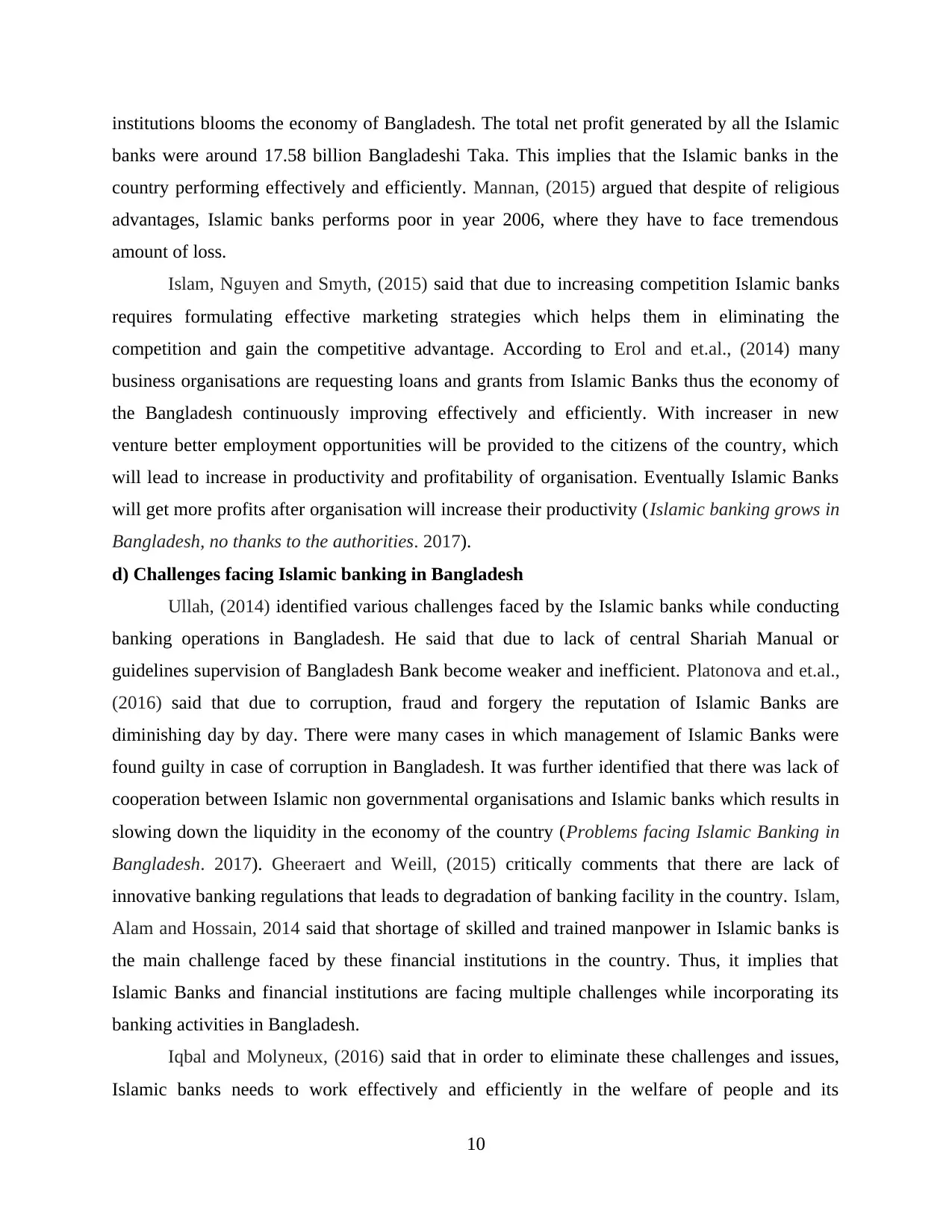
institutions blooms the economy of Bangladesh. The total net profit generated by all the Islamic
banks were around 17.58 billion Bangladeshi Taka. This implies that the Islamic banks in the
country performing effectively and efficiently. Mannan, (2015) argued that despite of religious
advantages, Islamic banks performs poor in year 2006, where they have to face tremendous
amount of loss.
Islam, Nguyen and Smyth, (2015) said that due to increasing competition Islamic banks
requires formulating effective marketing strategies which helps them in eliminating the
competition and gain the competitive advantage. According to Erol and et.al., (2014) many
business organisations are requesting loans and grants from Islamic Banks thus the economy of
the Bangladesh continuously improving effectively and efficiently. With increaser in new
venture better employment opportunities will be provided to the citizens of the country, which
will lead to increase in productivity and profitability of organisation. Eventually Islamic Banks
will get more profits after organisation will increase their productivity (Islamic banking grows in
Bangladesh, no thanks to the authorities. 2017).
d) Challenges facing Islamic banking in Bangladesh
Ullah, (2014) identified various challenges faced by the Islamic banks while conducting
banking operations in Bangladesh. He said that due to lack of central Shariah Manual or
guidelines supervision of Bangladesh Bank become weaker and inefficient. Platonova and et.al.,
(2016) said that due to corruption, fraud and forgery the reputation of Islamic Banks are
diminishing day by day. There were many cases in which management of Islamic Banks were
found guilty in case of corruption in Bangladesh. It was further identified that there was lack of
cooperation between Islamic non governmental organisations and Islamic banks which results in
slowing down the liquidity in the economy of the country (Problems facing Islamic Banking in
Bangladesh. 2017). Gheeraert and Weill, (2015) critically comments that there are lack of
innovative banking regulations that leads to degradation of banking facility in the country. Islam,
Alam and Hossain, 2014 said that shortage of skilled and trained manpower in Islamic banks is
the main challenge faced by these financial institutions in the country. Thus, it implies that
Islamic Banks and financial institutions are facing multiple challenges while incorporating its
banking activities in Bangladesh.
Iqbal and Molyneux, (2016) said that in order to eliminate these challenges and issues,
Islamic banks needs to work effectively and efficiently in the welfare of people and its
10
banks were around 17.58 billion Bangladeshi Taka. This implies that the Islamic banks in the
country performing effectively and efficiently. Mannan, (2015) argued that despite of religious
advantages, Islamic banks performs poor in year 2006, where they have to face tremendous
amount of loss.
Islam, Nguyen and Smyth, (2015) said that due to increasing competition Islamic banks
requires formulating effective marketing strategies which helps them in eliminating the
competition and gain the competitive advantage. According to Erol and et.al., (2014) many
business organisations are requesting loans and grants from Islamic Banks thus the economy of
the Bangladesh continuously improving effectively and efficiently. With increaser in new
venture better employment opportunities will be provided to the citizens of the country, which
will lead to increase in productivity and profitability of organisation. Eventually Islamic Banks
will get more profits after organisation will increase their productivity (Islamic banking grows in
Bangladesh, no thanks to the authorities. 2017).
d) Challenges facing Islamic banking in Bangladesh
Ullah, (2014) identified various challenges faced by the Islamic banks while conducting
banking operations in Bangladesh. He said that due to lack of central Shariah Manual or
guidelines supervision of Bangladesh Bank become weaker and inefficient. Platonova and et.al.,
(2016) said that due to corruption, fraud and forgery the reputation of Islamic Banks are
diminishing day by day. There were many cases in which management of Islamic Banks were
found guilty in case of corruption in Bangladesh. It was further identified that there was lack of
cooperation between Islamic non governmental organisations and Islamic banks which results in
slowing down the liquidity in the economy of the country (Problems facing Islamic Banking in
Bangladesh. 2017). Gheeraert and Weill, (2015) critically comments that there are lack of
innovative banking regulations that leads to degradation of banking facility in the country. Islam,
Alam and Hossain, 2014 said that shortage of skilled and trained manpower in Islamic banks is
the main challenge faced by these financial institutions in the country. Thus, it implies that
Islamic Banks and financial institutions are facing multiple challenges while incorporating its
banking activities in Bangladesh.
Iqbal and Molyneux, (2016) said that in order to eliminate these challenges and issues,
Islamic banks needs to work effectively and efficiently in the welfare of people and its
10
⊘ This is a preview!⊘
Do you want full access?
Subscribe today to unlock all pages.

Trusted by 1+ million students worldwide
1 out of 23
Related Documents
Your All-in-One AI-Powered Toolkit for Academic Success.
+13062052269
info@desklib.com
Available 24*7 on WhatsApp / Email
![[object Object]](/_next/static/media/star-bottom.7253800d.svg)
Unlock your academic potential
Copyright © 2020–2025 A2Z Services. All Rights Reserved. Developed and managed by ZUCOL.





